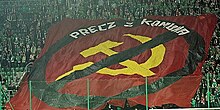
Back معاداة الشيوعية Arabic Anticomunismu AST Antikommunizm Azerbaijani Антыкамунізм Byelorussian Антыкамунізм BE-X-OLD Антикомунизъм Bulgarian Enepkomunouriezh Breton Anticomunisme Catalan Антикоммунизм CE دژە کۆمۆنیزم CKB

| Part of a series on |
| Communism |
|---|
 |
|
|
Anti-communism is political and ideological opposition to communist beliefs, groups, and individuals. Organized anti-communism developed after the 1917 October Revolution in Russia, and it reached global dimensions during the Cold War, when the United States and the Soviet Union engaged in an intense rivalry. Anti-communism has been an element of many movements and different political positions across the political spectrum, including anarchism, centrism, conservatism, fascism, liberalism, nationalism, social democracy, socialism, leftism, and libertarianism, as well as broad movements resisting communist governance. Anti-communism has also been expressed by several religious groups, and in art and literature.
The first organization which was specifically dedicated to opposing communism was the Russian White movement, which fought in the Russian Civil War starting in 1918 against the recently established Bolshevik government. The White movement was militarily supported by several allied foreign governments which represented the first instance of anti-communism as a government policy. Nevertheless, the Red Army defeated the White movement and the Soviet Union was created in 1922. During the existence of the Soviet Union, anti-communism became an important feature of many different political movements and governments across the world.
In the United States, anti-communism came to prominence during the First Red Scare of 1919–1920. During the 1920s and 1930s, opposition to communism in America and in Europe was promoted by conservatives, monarchists, fascists, liberals, and social democrats. Fascist governments rose to prominence as major opponents of communism in the 1930s. Liberal and social democrats in Germany formed the Iron Front to oppose communists, Nazi fascists, and revanchist conservative monarchists alike. In 1936, the Anti-Comintern Pact, initially between Nazi Germany and Imperial Japan, was formed as an anti-communist alliance.[1] In Asia, Imperial Japan and the Kuomintang (Chinese Nationalist Party) were the leading anti-communist forces in this period.
By 1945, the communist Soviet Union was among major Allied nations fighting against the Axis powers in World War II (WII.)[2] Shortly after the end of the war, rivalry between the Marxist–Leninist Soviet Union and liberal capitalist United States resulted in the Cold War. During this period, the United States government played a leading role in supporting global anti-communism as part of its containment policy. Military conflicts between communists and anti-communists occurred in various parts of the world, including during the Chinese Civil War, the Korean War, the First Indochina War, the Malayan Emergency, the Vietnam War, the Soviet–Afghan War, and Operation Condor. NATO was founded as an anti-communist military alliance in 1949, and continued throughout the Cold War.
After the Revolutions of 1989 and the dissolution of the Soviet Union in 1991, most of the world's communist governments were overthrown, and the Cold War ended. Nevertheless, anti-communism remains an important intellectual element of many contemporary political movements. Organized anti-communist movements remain in opposition to the People's Republic of China and other communist states.
- ^ "Anti-Comintern Pact". Encyclopædia Britannica. Retrieved 14 December 2021.
- ^ "Allied powers". Encyclopædia Britannica. Retrieved 14 December 2021.